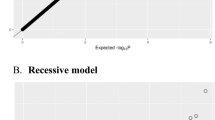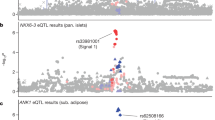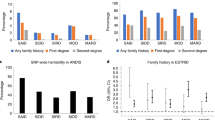Abstract
To reassess the type I diabetes (T1D) association of the OAS1 locus, the Type I Diabetes Genetics Consortium (T1DGC) genotyped 11 tag single-nucleotide polymorphisms spanning ∼41 kb from the 5′ to 3′ flanking region. For each sample obtained from over 2000 affected sib-pair families from nine cohorts, the genotyping was performed on both the Illumina Golden Gate and Sequenom iPlex platforms. The data suggest that there may be a weak association with T1D for two OAS1 polymorphisms, rs3741981 and rs10774671, in populations of European descent. The OAS1 locus is close to a recently identified T1D-associated linkage disequilibrium (LD) block in human chromosome 12q24. Extended LD in populations earlier examined may account for the prior observation of an association of T1D with OAS1 variants. This possibility needs to be addressed further by fine mapping of the T1D association represented in 12q24.
This is a preview of subscription content, access via your institution
Access options
Subscribe to this journal
Receive 6 digital issues and online access to articles
$119.00 per year
only $19.83 per issue
Buy this article
- Purchase on Springer Link
- Instant access to full article PDF
Prices may be subject to local taxes which are calculated during checkout
Similar content being viewed by others
References
Justesen J, Hartmann R, Kjeldgaard NO . Gene structure and function of the 2′–5′-oligoadenylate synthetase family. Cell Mol Life Sci 2000; 57: 1593–1612.
Mashimo T, Lucas M, Simon-Chazottes D, Frenkiel MP, Montagutelli X, Ceccaldi PE et al. A nonsense mutation in the gene encoding 2′–5′-oligoadenylate synthetase/L1 isoform is associated with West Nile virus susceptibility in laboratory mice. Proc Natl Acad Sci USA 2002; 99: 11311–11316.
Perelygin AA, Scherbik SV, Zhulin IB, Stockman BM, Li Y, Brinton MA . Positional cloning of the murine flavivirus resistance gene. Proc Natl Acad Sci USA 2002; 99: 9322–9327.
Lucas M, Mashimo T, Frenkiel MP, Simon-Chazottes D, Montagutelli X, Ceccaldi PE et al. Infection of mouse neurones by West Nile virus is modulated by the interferon-inducible 2′–5′ oligoadenylate synthetase 1b protein. Immunol Cell Biol 2003; 81: 230–236.
Bonnevie-Nielsen V, Field LL, Lu S, Zheng DJ, Li M, Martensen PM et al. Variation in antiviral 2′,5′-oligoadenylate synthetase (2′5′AS) enzyme activity is controlled by a single-nucleotide polymorphism at a splice-acceptor site in the OAS1 gene. Am J Hum Genet 2005; 76: 623–633.
Field LL, Bonnevie-Nielsen V, Pociot F, Lu S, Nielsen TB, Beck-Nielsen H . OAS1 splice site polymorphism controlling antiviral enzyme activity influences susceptibility to type 1 diabetes. Diabetes 2005; 54: 1588–1591.
Smyth DJ, Cooper JD, Lowe CE, Nutland S, Walker NM, Clayton DG et al. No evidence for association of OAS1 with type 1 diabetes in unaffected siblings or type 1 diabetic cases. Diabetes 2006; 55: 1525–1528.
Tessier MC, Qu HQ, Frechette R, Bacot F, Grabs R, Taback SP et al. Type 1 diabetes and the OAS gene cluster: association with splicing polymorphism or haplotype? J Med Genet 2006; 43: 129–132.
Wellcome Trust Case Control Consortium. Genome-wide association study of 14000 cases of seven common diseases and 3000 shared controls. Nature 2007; 447: 661–678.
Todd JA, Walker NM, Cooper JD, Smyth DJ, Downes K, Plagnol V et al. Robust associations of four new chromosome regions from genome-wide analyses of type 1 diabetes. Nat Genet 2007; 39: 857–864.
Brown WM, Pierce JJ, Hilner JE, Perdue LH, Lohman K, Lu L et al. and the Type I Diabetes Genetics Consortium. Overview of the Rapid Response data. Genes Immun 2009; 10(Suppl 1): S5–S15.
Horvath S, Xu X, Laird NM . The family based association test method: strategies for studying general genotype—phenotype associations. Eur J Hum Genet 2001; 9: 301–306.
Acknowledgements
This research uses resources provided by the Type I Diabetes Genetics Consortium, a collaborative clinical study sponsored by the National Institute of Diabetes and Digestive and Kidney Diseases (NIDDK), National Institute of Allergy and Infectious Diseases (NIAID), National Human Genome Research Institute (NHGRI), National Institute of Child Health and Human Development (NICHD), and Juvenile Diabetes Research Foundation International (JDRF) and supported by U01 DK062418. HQQ is supported by a fellowship from the Canadian Institutes of Health Research. We thank Dr John Todd for the helpful comments. Genotyping was performed at the Broad Institute Center for Genotyping and Analysis is supported by grant U54 RR020278 from the National Center for Research Resources.
Author information
Authors and Affiliations
Consortia
Corresponding author
Rights and permissions
About this article
Cite this article
Qu, HQ., Polychronakos, C. & the Type I Diabetes Genetics Consortium. Reassessment of the type I diabetes association of the OAS1 locus. Genes Immun 10 (Suppl 1), S69–S73 (2009). https://doi.org/10.1038/gene.2009.95
Published:
Issue Date:
DOI: https://doi.org/10.1038/gene.2009.95
Keywords
This article is cited by
-
A functional variant in the OAS1 gene is associated with Sjögren’s syndrome complicated with HBV infection
Scientific Reports (2017)
-
Mitochondrial localization of the OAS1 p46 isoform associated with a common single nucleotide polymorphism
BMC Cell Biology (2014)
-
Evaluate the relationship between polymorphisms of OAS1 gene and susceptibility to chronic hepatitis C with high resolution melting analysis
Clinical and Experimental Medicine (2013)
-
Identification of a new susceptibility variant for multiple sclerosis in OAS1 by population genetics analysis
Human Genetics (2012)
-
Overview of the Type I Diabetes Genetics Consortium
Genes & Immunity (2009)



